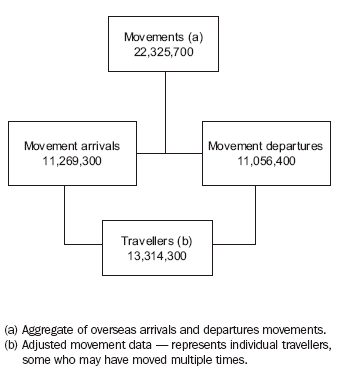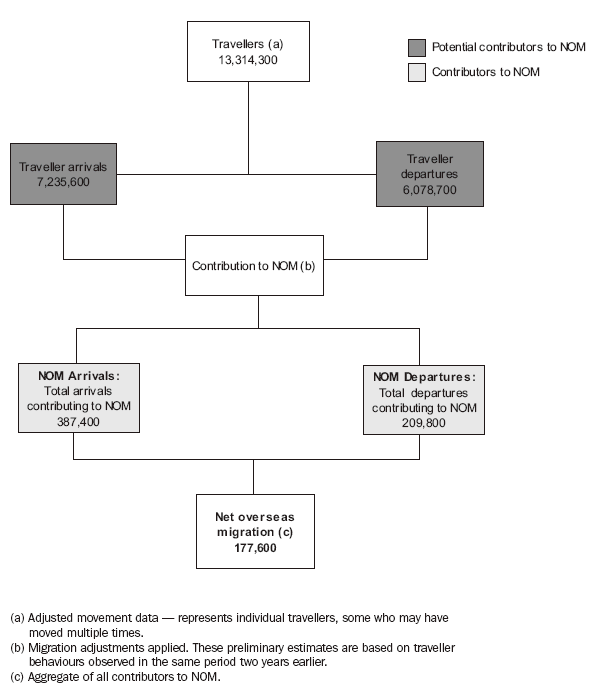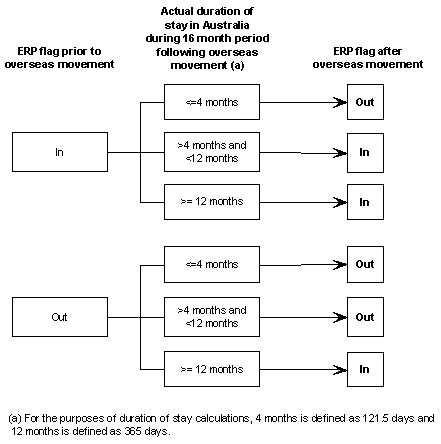IMPROVED METHODS OF CALCULATING NET OVERSEAS MIGRATION
In recent years, temporary migration has become increasingly important with students, business entrants and working holiday makers staying in Australia for periods between three months and four years. In addition some travellers are now able to apply for permanent residency whilst onshore. Australian residents are also departing overseas in greater numbers for all categories of travel. Overtime, these changing patterns have impacted on the ability to accurately measure Australia's net overseas migration.
In 2007 the ABS introduced improved methods for estimating NOM. This has been a result of reviewing the way we treat temporary migrants (both long-term and short-term) who are away from or resident in Australia for a period of 12 months or more. For information on the previous methods used refer to the Technical Note and paragraphs 18-26 of the Explanatory Notes.
In short, to be able to accurately measure people that have contributed to NOM estimates there are three main issues for consideration:-
- Is the person in or out of Australia's population prior to the overseas movement?
- Is the actual duration of stay within (or away from) Australia for at least 12 months?
- Is the person arriving or departing Australia?
The remainder of this chapter discusses these issues in relation to the improved methods of calculating NOM.
Net overseas migration and official population estimates
Net overseas migration is one component of population change used to estimate the Australian resident population, as are births and deaths. Officially the estimated resident population (ERP) is based on the concept of usual residence in Australia. According to recommendations of the United Nations an international migrant is defined as "any person who changes his or her country of usual residence"(footnote 1). For the purposes of NOM and therefore ERP, a person is regarded as a usual resident if they have been (or expected to be) residing in Australia for a period of 12 months or more. As such, the ERP includes all people, regardless of nationality or citizenship, who usually live in Australia, with the exception of foreign diplomatic personnel and their families.
Conceptually the term NOM is based on an international travellers' duration of stay being in or out of Australia for 12 months or more. It is the difference between the number of incoming travellers who stay in Australia for 12 months or more and are added to the population (NOM arrivals) and the number of outgoing travellers who leave Australia for 12 months or more and are subtracted from the population (NOM departures). With the introduction of the improved methods for estimating NOM this 12 months does not have to be continuous and is measured over a 16 month reference period. For example whether a traveller is in or out of the population is determined by their exact duration of stay in Australia over the subsequent 16 months after arrival or departure.
Previous 12/12 rule and new improved 12/16 rule
Prior to 1 July 2006, NOM estimation methods used a 12/12 rule to determine if a traveller contributed to ERP. This meant that in order for a person to contribute to NOM they must stay in or be absent from Australia for a continuous period of 12 months. With this methodology many overseas travellers with short-term interruptions to a longer period of stay/absence (e.g. overseas students in Australia) may have been continually excluded from NOM estimates. In addition, this previous method did not measure the exact duration of stay for all travellers.
The improved NOM estimation methods employ a 12/16 rule where the traveller can be added or subtracted from NOM if they have stayed in or been absent from Australia for a period of 12 months or more over a 16 month period. This 12 months does not have to be continuous. Although a traveller states their intended duration of stay on a passenger card, for NOM purposes the ABS now derives an individuals' actual travel behaviour.
Source of overseas migration data
Estimates of NOM are calculated using administrative data collected and compiled by the Department of Immigration and Citizenship (DIAC) under the authority of the Migration Regulations (Migration Act, 1958). At present, the main source of data on overseas migration is the incoming and outgoing passenger cards completed by all persons arriving in or departing from Australia. Data from passports and visa (entry permit) applications and approvals are also provided by DIAC's Travel and Immigration Processing System (TRIPS). These three data sources are collected, compiled and matched together by DIAC.
Conversion of overseas movements to travellers
At the time a traveller crosses Australia's boarder it is not empirically known how long they will spend in Australia (for an arrival) or overseas (for a departure). A key change for estimating NOM is a shift to a traveller-based approach that matches an individuals' boarder movements over time and creates individual traveller histories. The ABS now records their actual duration of stay over the 16 month reference period and accounts for any multiple movements that may have occurred. Previously the ABS based NOM estimates on a synthesis of movements which were converted to represent a traveller.
The difference between the number of movements and the number of travellers who make these movements, based on the improved methodology, is seen in Figure 3.6.
3.6 CONVERSION OF OVERSEAS MOVEMENTS TO TRAVELLERS - 2006-07

For 2006-07, the number of movements was 22,325,700 (the sum of all arrivals and all departures) as seen in Figure 3.6. Using the improved NOM estimation method, the number of movements is converted to travellers to become 13,314,300, a reduction of over 9 million movements.
Conversion of travellers contributing to net overseas migration
All travellers (excluding transport crew) are included in calculating NOM which is based on a travellers
actual duration of stay. Under the improved NOM estimation methods all traveller arrivals and all traveller departures are potential contributors to NOM as seen in Figure 3.7. Before a traveller can contribute to the NOM estimate, a series of migration adjustments are applied to reflect each individual travellers' actual travel behaviour (or expected for preliminary estimates). Through a number of these derivations both categories (arrivals and departures) contribute to the NOM estimate for a given period.
3.7 CONVERSION OF TRAVELLERS CONTRIBUTING TO NOM - 2006-07

Preliminary estimates are modelled on patterns of traveller behaviours observed in the final NOM estimates from two years earlier. For 2006-07 preliminary estimates were modelled on behaviours observed in 2004-05. Based on
actual duration of stay and direction of travel the preliminary estimates in Figure 3.7 shows how all travellers were converted into NOM arrivals and NOM departures. In other words those who stayed in (or away from) Australia for a period of 12 months or more. This 12 months does not have to be continuous and is measured over a 16 month reference period.
For 2006-07, these conversions resulted in a preliminary NOM estimate of 177,600 people who were added to the nations' population. This was 1.3% of all travellers who crossed Australia's boarders during this period.
Final NOM estimates
It is with the final NOM estimates that the 12/16 month rule can be fully applied. A traveller's actual duration of stay can only be calculated when data on overseas movements becomes available for the 16 months following a reference period. Final NOM estimation methods use ERP flags to determine if a traveller, through their actual duration of stay in or out of Australia, should be included or excluded from NOM estimates and consequently ERP estimates.
3.8 Derivation of estimated resident population (ERP) flags

As shown in Figure 3.8, the
actual duration of stay is used to calculate whether a traveller who is 'IN' or 'OUT' of the ERP before the movement is 'IN' or 'OUT' of the ERP after the movement, regardless of their
intended duration of stay. Each traveller moving into the ERP during a reference quarter is added to the total NOM estimate for the quarter. Similarly, each traveller moving out of the ERP is subtracted from the NOM estimate.
Preliminary NOM estimates
Preliminary NOM estimates contribute to ERP data which the ABS is legally obliged to produce each quarter. As the improved methods require 16 months of data to calculate actual duration of stay in or out of Australia, preliminary NOM estimates are therefore modelled on patterns of traveller behaviours observed in final NOM estimates for the same period two years earlier. Migration adjustments are then applied to account for differences between their intended duration of stay and their actual duration of stay. These migration adjustments are applied to travellers who are grouped according to age, sex, country of citizenship and state. They are calculated from changes in behaviour from final estimates two years earlier for the comparable groups of travellers.
More detailed information
For more detailed information on the improved NOM estimation methods see Information Paper: Improved Methods for Estimating Net Overseas Migration, 2006 (cat. no. 3107.0.55.003) and Information Paper: Statistical Implications of Improved Methods for Estimating Net Overseas Migration, Australia, 2007 (cat. no .3107.0.55.005).
1 United Nations 1998, Recommendations on Statistics of International Migration, Revision 1, Statistical Series M, No 58, Rev.1, New York: Department of Economic and Social Affairs, Statistics Division. <back
 Print Page
Print Page
 Print All
Print All
 Quality Declaration
Quality Declaration